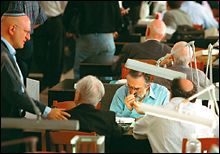
The price of diamonds is updated every week by Martin Rapaport, who established the first diamond price lists in 1978 (called the «Rapaport Diamond Report» and also known as the «Rap» or the «List» by diamond merchants).
Using these price lists (the «Rapaport»), it is possible to track the progression of diamond prices over the past few decades.
Certain types of diamonds have gone up significantly since 1978, while others have increased only slightly, so there are no common rules governing changes in diamond prices: they vary depending on the weight, color, and clarity of the diamond.
Examples of diamond price changes over 1 year (2005):
- The price of a 0.35 carat round cut diamond D color and IF clarity went down during 2005: a 2.13% decrease.
- The price of a 1.00 carat round cut diamond D color and IF clarity went up during 2005: a 1.69% increase.
- The price of a 2.00 carats round cut diamond D color and IF clarity went up during 2005: a 10.14% increase.
Examples of diamond price changes for 3 years (2003 to 2005):
- The price of a 0.40 carat round cut diamond I color and VVS2 clarity went up during this period: a 9.00% increase.
- The price of a 1.00 carat round cut diamond F color and VVS2 clarity went up during this period: a 17.00% increase.
- The price of a 4.00 carats round cut diamond H color and SI2 clarity went up during this period: a 41.00% increase.
The price increase for colorless diamonds weighing 1.00 carat or more has been significant since 2003. For example, the price of a 4 carats round cut diamond of (H-SI) quality increased 20-25% for 2005. Such a diamond today would be worth between $64,413.00 and $86,550.00 on the retail market, so you can see that a 20-25% increase in its price during one year is a significant amount.
Some color diamonds have increased considerably in value in recent years. This price increase was much greater than for colorless diamonds during the same period. Certain color diamonds are so rare (blues, pinks, reds, or greens) that demand largely exceeds available supply: fewer than 0.30% of the color diamonds appraised by the GIA in the first half of 1998 were described as being predominantly blue. This imbalance between supply and demand has driven up their prices; for example, the value of blue diamonds increased 20-30% between 2003 and 2005. Since there are no price lists for color diamonds, it is difficult to track the price changes in this diamond category, so auction sale results for these types of diamonds are a good barometer, a good indicator. In this regard, selling price records are broken with fair regularity at prestigious auction sales held by Sotheby's or Christie's. There is a clientele of professionals and/or collectors who are ready to spend a fortune for a very intense blue or pink color diamond, or for a green or red diamond. Nor is it rare for these exceptional diamonds to be offered directly for sale to auctions rather than to diamond cutters or merchants, because the owner of such a diamond can definitely get more at auction than anywhere else. On our website and by subscription we offer access to a fancy color diamond prices simulator.

A 3.16 carats Fancy Intense Blue cushion cut diamond with VS1 clarity was sold at a Sotheby's auction in New York in December 2005, for $1,091,198, i.e., $345,316 per carat (non-contractual photo).
By comparison, a colorless diamond of the best quality (D color and IF clarity), cut, and weight would cost «only» $152,214. for the stone

A 5.31 carats Fancy Intense Pink pear shape diamond with VVS2 clarity was sold at a Sotheby's auction in Hong Kong in April 2006, for $1,142,425, i.e., $215,146 per carat (non-contractual photo).
By comparison, a colorless diamond of the best quality (D color and IF clarity), cut, and weight would cost «only» $415,434 for the stone.

A 3.19 carats Fancy Green cushion cut diamond was sold at a Christie's auction in Geneva in November 2005, for $394,855, i.e., $123,779 per carat (non-contractual photo).
By comparison, a colorless diamond of the best quality (D color and IF clarity), cut, and weight would cost «only» $124,248 for the stone.

A 0.95 carat Fancy Purplish Red round cut diamond (the «Hancock Red Diamond») was sold in April 1987, for $880,000, i.e., $926,315 per carat (non-contractual photo).
By comparison, a colorless diamond of the best quality (D color and IF clarity), cut, and weight would cost «only» $10,312 for the stone.
For those who are interested, on our website and by subscription we offer access to a diamond pricing simulator for weights of 0.01-10.99 carats, for all qualities (D to M color and IF to I3 clarity) and for all cuts/shapes. It will calculate and display the diamond's price progression, expressed as a percentage and compared to a reference period, so you can compare the diamond's price progression over recent months or years based on multiple criteria (cut, weight, color, etc...). For more information, click on this link diamond pricing calculator.
